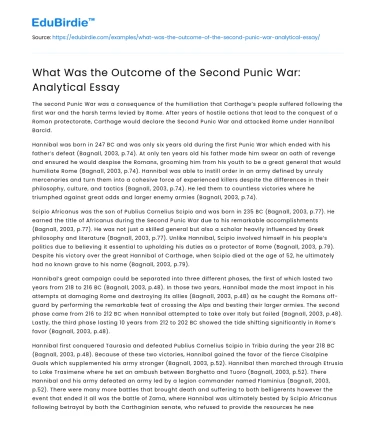The second Punic War was a consequence of the humiliation that Carthage’s people suffered following the first war and the harsh terms levied by Rome. After years of hostile actions that lead to the conquest of a Roman protectorate, Carthage would declare the Second Punic War and attacked Rome under Hannibal Barcid.
Hannibal was born in 247 BC and was only six years old during the first Punic War which ended with his father’s defeat (Bagnall, 2003, p.74). At only ten years old his father made him swear an oath of revenge and ensured he would despise the Romans, grooming him from his youth to be a great general that would humiliate Rome (Bagnall, 2003, p.74). Hannibal was able to instill order in an army defined by unruly mercenaries and turn them into a cohesive force of experienced killers despite the differences in their philosophy, culture, and tactics (Bagnall, 2003, p.74). He led them to countless victories where he triumphed against great odds and larger enemy armies (Bagnall, 2003, p.74).
Save your time!
We can take care of your essay
- Proper editing and formatting
- Free revision, title page, and bibliography
- Flexible prices and money-back guarantee
Scipio Africanus was the son of Publius Cornelius Scipio and was born in 235 BC (Bagnall, 2003, p.77). He earned the title of Africanus during the Second Punic War due to his remarkable accomplishments (Bagnall, 2003, p.77). He was not just a skilled general but also a scholar heavily influenced by Greek philosophy and literature (Bagnall, 2003, p.77). Unlike Hannibal, Scipio involved himself in his people’s politics due to believing it essential to upholding his duties as a protector of Rome (Bagnall, 2003, p.79). Despite his victory over the great Hannibal of Carthage, when Scipio died at the age of 52, he ultimately had no known grave to his name (Bagnall, 2003, p.79).
Hannibal’s great campaign could be separated into three different phases, the first of which lasted two years from 218 to 216 BC (Bagnall, 2003, p.48). In those two years, Hannibal made the most impact in his attempts at damaging Rome and destroying its allies (Bagnall, 2003, p.48) as he caught the Romans off-guard by performing the remarkable feat of crossing the Alps and besting their larger armies. The second phase came from 216 to 212 BC when Hannibal attempted to take over Italy but failed (Bagnall, 2003, p.48). Lastly, the third phase lasting 10 years from 212 to 202 BC showed the tide shifting significantly in Rome’s favor (Bagnall, 2003, p.48).
Hannibal first conquered Taurasia and defeated Publius Cornelius Scipio in Tribia during the year 218 BC (Bagnall, 2003, p.48). Because of these two victories, Hannibal gained the favor of the fierce Cisalpine Guals which supplemented his army stronger (Bagnall, 2003, p.52). Hannibal then marched through Etrusia to Lake Trasimene where he set an ambush between Borghetto and Tuoro (Bagnall, 2003, p.52). There Hannibal and his army defeated an army led by a legion commander named Flaminius (Bagnall, 2003, p.52). There were many more battles that brought death and suffering to both belligerents however the event that ended it all was the battle of Zama, where Hannibal was ultimately bested by Scipio Africanus following betrayal by both the Carthaginian senate, who refused to provide the resources he needed, and the Numidians, who defected in favor of the Romans (Bagnall, 2003, p.66).






 Stuck on your essay?
Stuck on your essay?

